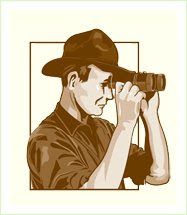My tent at Byan Dzag [ Flaming Cliffs ]. Photo. by Clive Coy
Over the course of his life Andrews was the recipient of many prestigious awards, including, the Elisha Kent Kane Gold Medal of the Philadelphia Geographical Society [1929], the Hubbard Gold Medal of the National Geographic Society [1931], the Explorers’ Gold Medal [1932], and the Charles P. Daly Gold Medal of the American Geographical Society [1936]. Honorary Sc. D. degrees were conferred on him by Brown University [1926], and by Beloit College [1928].
Elisha Kent Kane Medal. Photo by Clive Coy.
In recognition of his qualities as organiser and leader, Andrews has eleven animals, fossil and living, named in his honour by ten separate researchers between 1911 and 1981, including one by a Soviet palaeontologist. Contrary to popular belief, scientists do not name new discoveries after themselves, and even in today’s jaded world it is still considered an honour to have new discoveries named in recognition of the discoverer.
Still writing books, and corresponding with admirers around the world, Andrews made his last and longest journey on March 11, 1960. His passing was reported on the front-page of major newspapers, and from the world came tributes to “one of the greatest naturalists and zoologists of the 20th century”. “Roy Chapman Andrews was one of the truly fortunate men who know exactly what they want to do in the world.”, reported the New York Times. Inexplicably, the institution that he had worked so hard for made no mention of his passing in the yearly report or popular magazine that Andrews himself had written 24 articles for.
Andrews, Colebrook, Conn., 1953. Hunting license pinned to his Fedora.
Filled with a thirst for life, Andrews lived it to the fullest. He had a restless spirit, an exuberant personality, a determined will, and limitless energy. Fieldwork and exploration, not paper work, consumed him. Not content merely to see the world, he wanted to know its closely kept secrets. For three decades he was the popular ideal of the romantic explorer, combining scientific ability and the capacity to direct major expeditions with the showmanship necessary to obtain publicity and financial support.
Expeditions to Northern China and Mongolia conducted by the Russians, Chinese, Poles, Canadians, Japanese, and Americans owe much to the pioneering work of Roy Chapman Andrews, whose significance lies both in his own findings and in the international attention he drew to the role and value of the explorer-naturalist and the modern interdisciplinary scientific expedition.
ROY CHAPMAN ANDREWS
An Informal Checklist of Books
Publication statistics for Andrews’ books appear to be undocumented. Several of his publishers have ceased to exist, or have not retained records from the periods involved. The later children’s books are not difficult to obtain, although as in almost all juvenile literature, condition is a common problem. Books published previous to 1929 are scarce in even very good condition, and dust wrappers for the first three books are very uncommon.
[NF] nonfiction; [F] fiction; [NF - J] nonfiction juvenile; [F - J] fiction juvenile
1. Whale Hunting With Gun And Camera [NF]
NY; D. Appleton and Company, 1916
2. Camps And Trails In China [NF]
NY; D. Appleton and Company, 1918
3. Across Mongolian Plains [NF]
NY; D. Appleton and Company, 1921
4. On The Trail Of Ancient Man [NF]
NY; G. P. Putnam’s Sons, 1926
5. Ends Of The Earth [NF]
1929 G. P. Putnam’s Sons New York / London
6. The New Conquest Of Central Asia [NF]
NY; American Museum of Natural History New York / G. P. Putnam’s Sons, 1932
7. This Business Of Exploring [NF]
NY; G. P. Putnam’s Sons, 1935
8. Exploring With Andrews [NF - J]
NY; G. P. Putnam’s Sons, 1938
9. This Amazing Planet [NF]
NY; G. P. Putnam’s Sons, 1940
10. Under A Lucky Star [NF]
NY; The Viking Press, 1943
11. Meet Your Ancestors [NF]
NY; The Viking Press, 1945
12. An Explorer Comes Home [NF]
NY; Doubleday and Company, 1947
13. My Favorite Stories Of The Great Outdoors [NF]
NY; Greystone Press, 1950
14. Quest In The Desert [F - J]
NY; The Viking Press, 1950
15. Heart Of Asia [NF]
NY; Duell, Sloan and Pearce, 1951
16. Nature’s Ways [NF]
NY; Crown Publishers, 1951
17. All About Dinosaurs {NF- J]
NY; Random House, 1953
18. All About Whales [NF - J]
NY; Random House, 1954
19. Beyond Adventure [NF]
Boston / Toronto; Duell, Sloan and Pearce / Little Brown and Company, 1954
20. Quest Of The Snow Leopard [F - J]
NY; The Viking Press, 1955
21. All About Strange Beasts Of The Past [NF - J]
NY; Random House, 1956
22. In The Days Of The Dinosaurs [NF - J]
NY; Random House, 1959





































